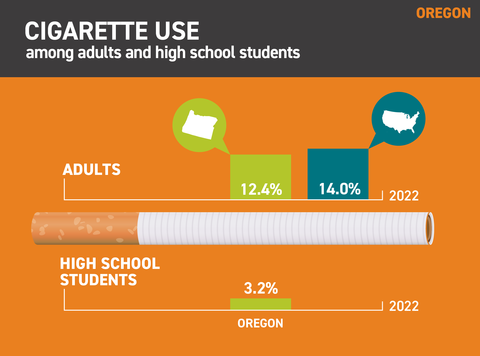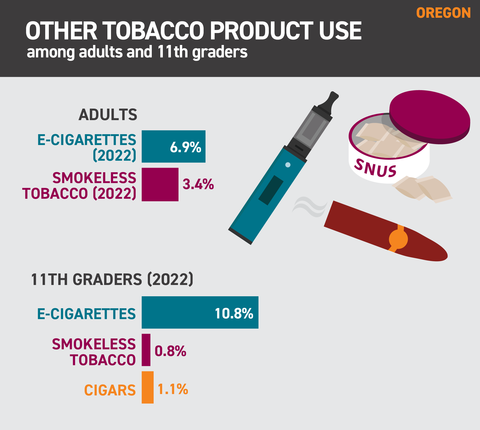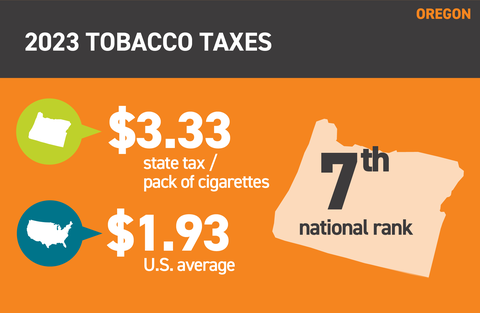Tobacco use in Oregon 2023
Cigarette use: Oregon*
Cigarette smoking rate in Oregon
- In 2022, 12.4% of adults smoked. Nationally, adult smoking prevalence was 14.0%.1
- In 2022, 3.2% of 11th graders in Oregon smoked cigarettes on at least one day in the past 30 days.3
Other tobacco product use: Oregon*
Vaping rate in Oregon
- In 2022, 6.9% of adults in Oregon used e-cigarettes. Nationally, adult e-cigarette use prevalence was 7.7%.1
- In 2022, 3.4% of adults in Oregon used smokeless tobacco every day or some days. Nationally, adult smokeless tobacco use prevalence was 3.4%.1
- In 2022, 10.8% of 11th graders in Oregon used electronic vapor products on at least one day in the past 30 days.3
- In 2022, 0.8% of 11th graders in Oregon used chewing tobacco, snuff or dip on at least one day in the past 30 days. 3
- In 2022, 1.1% of 11th graders in Oregon smoked little cigars on at least one day in the past 30 days. 3
Economics of tobacco use and tobacco control
Tobacco taxes in Oregon
- Oregon received $511.2 million (estimated) in revenue from tobacco settlement payments and taxes in fiscal year 2023. 4
- Of this, the state allocated $53.1 million in state funds to tobacco prevention in fiscal year 2022, 135.1% of the Centers for Disease Control and Prevention’s annual spending target.4
- Smoking-caused health care costs: $1.79 billion per year.4
- Smoking-caused losses in productivity: $3.7 billion per year.5
Oregon tobacco laws
Oregon tobacco laws
Tobacco taxes
- Oregon is ranked 7th in the U.S. for its cigarette tax of $3.33 per pack (enacted January 2021), compared to the national average of $1.93. (New York has the highest tax at $5.35 and Missouri has the lowest at 17 cents.) 6-8
- Cigars are taxed at 65% of the wholesale sales price of cigars (not to exceed $1 per cigar).
- Moist snuff is taxed at $1.78 per ounce, except that the minimum tax per retail container is $2.14.
- All other tobacco products, including e-cigarettes, are taxed at 65% of the wholesale sales price. 6,7
Clean indoor air ordinances
- Smoking is prohibited in all enclosed public places. This includes government workplaces, private workplaces, schools, childcare facilities, restaurants, bars, casinos/gaming establishments (tribal establishments exempt), retail stores, and recreational/cultural facilities.6,7 A small number of cigar bars and smoke shops are exempted and allow smoking indoors.
- E-cigarettes and combustible cannabis are included in the state’s clean indoor air law.9
- Use of combustible tobacco products and e-cigarettes in a car while a person under the age of 18 is present or in state vehicles is prohibited.9
Licensing laws
- Retailers are required to obtain a license to sell tobacco products and e-cigarettes. Wholesalers and distributors are required to obtain a license to sell tobacco products and e-cigarettes.6
Youth access laws
- In December 2019, the United States adopted a law raising the federal minimum age of sale of all tobacco products to 21, effective immediately.
- Establishments are required to post signs stating that the sale of tobacco products to people under 21 is prohibited.6
- People under 21 are prohibited from buying e-cigarettes.6
- Self-service displays and vending sales of e-cigarettes are prohibited. Vending machine sales of cigars are allowed in locations inaccessible to persons under 21.9
- Public and private schools, colleges, community colleges, university career schools, technical education schools, and youth correction and juvenile detention facilities must prohibit possession of e-cigarettes by people under 21 at facilities or facility-sponsored events.
- Recreational marijuana dispensaries are prohibited from selling products that combine nicotine and cannabinoids.10
- E-cigarette sales require face-to-face age verification by the licensed retailer.9
Local tobacco laws
- Multnomah County and Washington County prohibit the sale of all flavored tobacco products. However, both ordinances are currently on hold due to legal actions by the tobacco industry.10
Quitting statistics and benefits
Quitting smoking and vaping in Oregon
- The CDC estimates 50.4% of daily adult smokers in Oregon quit smoking for one or more days in 2019.2
- In 2014, the Affordable Care Act required that Medicaid programs cover all tobacco cessation medications.7**
- Oregon’s state quit line invested $1.49 per smoker as of last year, compared to the current national median of $2.37. 7
- Oregon has a private insurance mandate provision for cessation.7
Notes and references
Notes and references
Updated June 2023
* The datasets for both adults and youth prevalence were used to make direct comparisons at the state and national levels. National prevalence reported here may differ from what is reported in our national-level fact sheets. The numbers here also reflect the most recent data available. Dates of available data may differ across state fact sheets.
**The seven recommended cessation medications are NRT gum, NRT patch, NRT nasal spray, NRT inhaler, NRT lozenge, Varenicline (Chantix) and Bupropion (Zyban).
Fiore MC, et al. Treating Tobacco Use and Dependence: 2008 Update. Clinical Practice Guideline. Rockville, MD: US Department of Health and Human Services. Public Health Service: May 2008.
1. CDC, Behavioral Risk Factor Surveillance System, 2022.
2. CDC, Behavioral Risk Factor Surveillance System, State Tobacco Activities Tracking and Evaluation System, 2021.
3. Oregon Student Health Survey, 2022.
4. Campaign for Tobacco-Free Kids, Broken Promises to Our Children: a State-by-State Look at the 1998 State Tobacco Settlement 24 Years Later FY2023, 2023.
5. Campaign for Tobacco-Free Kids, Toll of Tobacco in the United States.
6. American Lung Association, State Legislated Actions on Tobacco Issues (SLATI).
7. American Lung Association, State of Tobacco Control, 2023.
8. Campaign for Tobacco-Free Kids. State Cigarette Excise Tax Rates & Rankings. https://www.tobaccofreekids.org/assets/factsheets/0097.pdf. Accessed October 4th, 2023.
9. Public Health Law Center. U.S. E-Cigarette Regulation: 50-State Review. http://www.publichealthlawcenter.org/resources/us-e-cigarette-regulations-50-state-review. Accessed October 4th, 023.
10. Truth Initiative, Local restrictions on flavored tobacco and e-cigarette products. https://truthinitiative.org/research-resources/emerging-tobacco-products/local-restrictions-flavored-tobacco-and-e-cigarette. Accessed October 4th, 2023.




